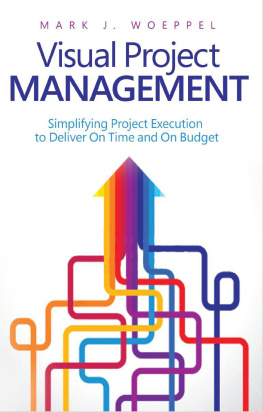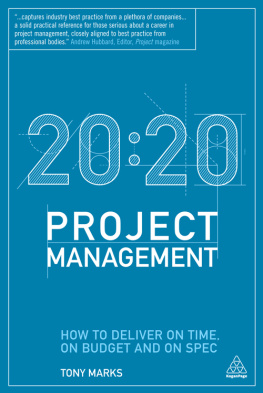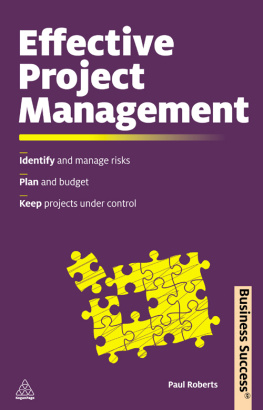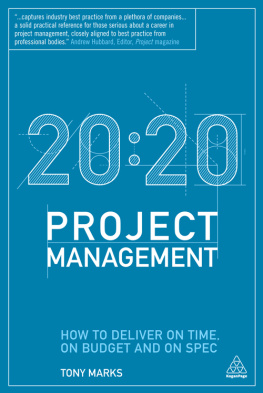Visual Project
MANAGEMENT
Mark J. Woeppels Other Books
The Manufacturers Guide to
Implementing the Theory of Constraints
Projects in Less Time:
A Synopsis of Critical Chain
Copyright 2015 by Mark J. Woeppel
All Rights Reserved.
No part of this book may be reproduced, stored in a retrieval system or transmitted in any form by an electronic, mechanical, photocopying, recording means or otherwise without prior written permission of the publisher.
For more information contact:
mwoeppel@pinnacle-strategies.com
65050 W. Park Suite 306-335
Plano, TX 75093
ISBN paperback: 978-0-692-42325-7
ISBN eBook: 978-0-692-42326-4
Library of Congress Control Number: 2015938015
CONTENTS
PART I
Why Are Projects Always Late and Over Budget?
PART II
Delivering Your Projects on Time and on Budget
Acknowledgments
Rarely is something completely original invented; we all stand on the shoulders of giants in the creative process. The work of Sanjeev Gupta of Realization Technologies and Eliyahu Goldratt was foundational to the approach we created. Thank you.
There were also several people who slogged through early versions of the manuscript and provided insight and correction, and, in some cases, stories that were used in the book. To my colleagues at Pinnacle Strategies: Orval Duke Porritt, Cory TerEick, Trevor Calder, Stephane Luthi, and Ian Wong, thank you for your contribution to this work. It would not be what it is without your help.
Last, and probably not least important, are my clients, many of whom have become personal friends. Thank you for entrusting me with your business; I learn something new on every projectand some of it is actually useful! My wish is that you see yourselves in these pages in a flattering light.
Introduction
The fact that many projects are delivered late and over budget is widely known, but rarely acknowledged. The frequency with which they fail is astonishing. Whether the project is to implement a new technology strategy, or a capital project, they require significant investments that last months or years. For organizations that commission these projects, the underwhelming track record of delivery combined with the investments creates significant risk.
To reduce this risk, many organizations have invested in their project management capabilities. Yet, despite spending millions of dollars in training and the development of greater project management maturity, the ability to consistently execute on time and on budget eludes us.
We at Pinnacle Strategies reached this depressing conclusion in 2014 after commissioning an independent study of project management practices and results from around the world. We examined the survey responses from over 4,000 project managers and senior executives, comparing their budgets and estimated performance benefits with the actual costs and results. Their projects ran the gamut, from large IT projects to engineering, procurement, and construction (EPC) projects, to strategic business initiatives. Most were expensivefor large IT projects, the average cost was $167 million, and the largest was $33 billionand many took several years. Our sample drew from respondents around the world, but we found little difference among them in the results.
We found that project cost overruns were commonplace. For example, a recent Accenture surveythat more than 30 percent of capital projects are now completed over budget, and more than 35 percent of projects are finished late.
The problem isnt that we dont have enough skills, training, or centers of excellence. Its that what we do have is focused on control: scope, change, stakeholder management, etc. We have very little ability to consistently execute projects on time or on budget in the face of a constantly shifting reality.
Clearly something is missing from project management practice. What are the principles and best practices for delivering projects on time and on budget? Should we accept the generally accepted solution as being the best or correct solution? Should we continue to depend on the art of the project manager?
In this book, Im going to show you the foundational causes of on-time, on-budget project execution. Surprisingly, they have little to do with planning. I, along with my colleagues at Pinnacle Strategies, have discovered that by focusing on the processes and behaviors associated with project execution, executives can govern their portfolios more effectively to deliver projects in less time and at a lower cost. At the same time, the project teams decision-making processes can be made sharper and better aligned with the entire organization to execute projects when they are most needed, and with less drama.
This book will highlight the core principles that project teams can employno matter what environment theyre into reduce project durations, improve delivery performance, and stay on budget.
Ill be introducing the project execution methodology called ViewPoint. With ViewPoint, you can transform any project.
ViewPoint:
Eliminates the silo effect on project teams, streamlining and improving communication and accountability;
Is a streamlined approach to managing project execution, delivering fast, significant results to improve schedule and budget performance;
Is easily understood, with few obstacles to implementation;
Can easily be adapted by any organization, regardless of current practice and maturity;
Works with and complements existing methodologies and software;
Generates maximum buy-in to changes, or at least generates no significant opposition; and
Makes completing your projects a satisfying experience, not a battle to win.
If youre a fan of the Critical Chain Project Management methodology, as I am, youll find a clear path to building your implementation, graduating from simple tactics to sophisticated methods of managing your portfolio with this method. Along the way, youll be able to engage your teams and your organization with a logical, successful model.
After reading this, you may accuse me of oversimplifying the task of managing projects. I fully understand that not everything thats important can be fully explained in a book of this length. There are plenty of texts about risk management, controls, scheduling, stakeholder engagement, etc. What I hope to do is shed some light on an area of project management that has been overlooked.
Dont forget what managing projects is aboutits not about things, and its not about procedures or controls. Project managementsuccessful project managementis about people.
Portfolio results are generated at the project level, and project results are generated at the deliverables, and deliverables are created by peopleyour most critical resourceaccomplishing tasks. Thus, no portfolio or project manager can improve their results without paying attention to what creates those results. In a sense, your portfolio and project strategy is dependent upon the tactics, and the tactics can dictate the strategy.
With the ViewPoint methodology, youll find all of the abovein short, successful project management. Throughout this book, Ill explore the philosophy behind effective project delivery, and Ill give you a map that you can use to make it happen in your own organization. Im going to show you methods, principles, and practices that have worked in multiple environmentsconsistently. In ViewPoint, youll find the answer to consistently executing projects on time on budget.
Next page












